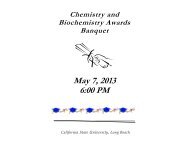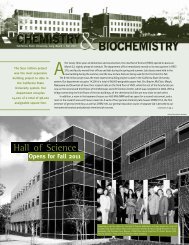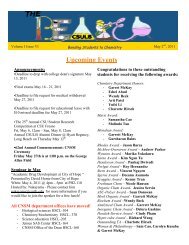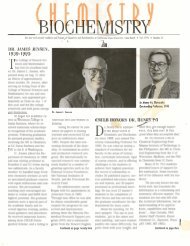2010 - California State University, Long Beach Department of ...
2010 - California State University, Long Beach Department of ...
2010 - California State University, Long Beach Department of ...
Create successful ePaper yourself
Turn your PDF publications into a flip-book with our unique Google optimized e-Paper software.
6<br />
New Powder<br />
X-ray Diffraction<br />
Instrument<br />
By Dr. Shahab Derakhshan<br />
The new powder X-ray diffractometer<br />
(XRD) in my research laboratory is a<br />
valuable addition to the single crystal<br />
X-ray machine in Dr. Xianhui Bu’s lab and<br />
completes our instrumental needs for crystallography<br />
tasks. When single crystals with<br />
suitable sizes are not available, powder diffraction<br />
techniques are unique tools for<br />
crystal structure determination. In addition,<br />
the XRD instrument enables us to confirm<br />
the formation <strong>of</strong> desired phases, phase<br />
homogeneity and, if present, the type <strong>of</strong><br />
side products in polycrystalline samples.<br />
The Panalytical X’pert Pro Alpha1 system<br />
is equipped with a state-<strong>of</strong>-the-art<br />
X’Celerator ultrafast detector. The monochromatic<br />
incident beam results in highresolution<br />
diffraction patterns.<br />
The XRD instrument is housed in MLSC<br />
302 and will be available for all interested<br />
faculty labs in our department. This will<br />
particularly be beneficial for materials<br />
research labs. In addition, researchers from<br />
other departments such as Physics and<br />
Astronomy, Geological Sciences, Chemical<br />
Engineering, and Mechanical and Aerospace<br />
Engineering will be able to use this instrument<br />
in collaborative research projects.<br />
The XRD system will also be employed<br />
in CHEM 332: Inorganic Chemistry Laboratory<br />
and CHEM 531: Advances in Inorganic<br />
Chemistry. The students will get hands-on<br />
experience in obtaining diffraction patterns<br />
and in analyzing the diffraction data. This<br />
will provide a great opportunity for our<br />
students to understand both the principles<br />
<strong>of</strong> diffraction techniques and their applications<br />
in crystallographic structure<br />
determination.<br />
By Dr. Michael P. Schramm<br />
Dr. Julius Rebek, Jr.<br />
2009 Allergan Distinguished Lecturer<br />
The <strong>Department</strong> <strong>of</strong> Chemistry and Biochemistry was privileged to host Dr. Julius Rebek, Jr., a<br />
chemistry pr<strong>of</strong>essor at The Scripps Research Institute and director <strong>of</strong> The Skaggs Institute for<br />
Chemical Biology, as the 2009 Allergan Distinguished Lecturer. Dr. Rebek visited our department<br />
on Nov. 18. He presented two riveting talks: one, a lecture for a general audience; and the other, a<br />
technical seminar on the topic <strong>of</strong> molecular recognition and molecular self-assembly.<br />
Dr. Rebek received his Ph.D. degree in 1970 from the Massachusetts<br />
Institute <strong>of</strong> Technology, studying peptide chemistry with Dr. D.S.<br />
Kemp. He was appointed director <strong>of</strong> The Skaggs Institute for Chemical<br />
Biology in 1996 after academic appointments at UCLA, <strong>University</strong> <strong>of</strong><br />
Pittsburgh and MIT, where he was the Camille Dreyfus Pr<strong>of</strong>essor <strong>of</strong><br />
Chemistry from 1991-96.<br />
Dr. Rebek’s early work included development <strong>of</strong> the three-phase<br />
test for reactive intermediates and invention <strong>of</strong> molecular cleft structures<br />
for molecular recognition. He was a pioneer in developing the<br />
first synthetic, self-replicating molecules (J. Am. Chem. Soc., 1990, 112,<br />
1249-1250). He has received numerous prestigious awards, given scores <strong>of</strong> presentations under named<br />
lectureships, is an editorial advisory board member for many high-impact publications and commercial<br />
companies, and has authored over 425 publications.<br />
Dr. Rebek continues to be a leader in the field <strong>of</strong> molecular recognition and self-assembly. In his<br />
first lecture, “Molecular Assembly and Encapsulation,” he described some <strong>of</strong> his group’s first efforts to<br />
develop molecules that assemble and encapsulate other molecules. In these complexes, new chemical<br />
phenomena emerge. Using NMR spectroscopy as a tool, Dr. Rebek convincingly demonstrated the driving<br />
force that dictates self-assembly: appropriate filling <strong>of</strong> space. Moreover, these new assemblies<br />
allow for the study <strong>of</strong> chemical phenomena within the capsules with time scales from milliseconds to<br />
hours that could not otherwise be observed in solution, where the lifetimes <strong>of</strong> the relevant species are<br />
too short. The NMR data was quite cleverly used to develop a series <strong>of</strong> breathtaking animations that<br />
Rebek played for the audience, giving his best description <strong>of</strong> the actual physical behavior based on<br />
chemical observation.<br />
A second—standing room only—technical lecture elaborated on “The Inner Space <strong>of</strong> Molecules,”<br />
where themes from earlier in the day were revisited in depth and applied to assemblies <strong>of</strong> greater<br />
complexity and assemblies in which more than one guest is encapsulated in larger capsules. In these<br />
studies, several new forms <strong>of</strong> stereoisomerism emerge. Molecules held in new arrangements give new<br />
and thought-provoking challenges to conventional definitions <strong>of</strong> isomers. Dr. Rebek then elaborated on<br />
some unusual contortions that molecules undergo as they are “driven” to fill space inside cavitands<br />
and capsules. A new expanded capsule emerges when a seam <strong>of</strong> spacers is introduced. This arrangement<br />
allows a long alkyl chain to go from a compressed and coiled conformation to a more familiar<br />
expanded zigzag conformation. This behavior mimics our everyday notion <strong>of</strong> the compression <strong>of</strong> a<br />
spring, except now it is reduced to the molecular level. An encapsulation complex <strong>of</strong> anandamine is<br />
shown below with two “seams” <strong>of</strong> spacer molecules that allow this lengthy molecule to fill the space<br />
defined by the two capsule halves at the<br />
end. Coiling and kinks <strong>of</strong> the guest<br />
emerge with unfavorable energetic consequences;<br />
in the end, the energetic<br />
benefit <strong>of</strong> encapsulation wins!<br />
Throughout the lectures, despite<br />
the complex experiments required to prove the existence <strong>of</strong> such complexes, Dr. Rebek had a masterful<br />
way <strong>of</strong> keeping the audience on the edge <strong>of</strong> their seats, awaiting the next detail, discovery or animation.<br />
It was truly a privilege for the department to host Dr. Rebek as our 2009 Allergan Distinguished<br />
Lecturer. We are very grateful to The Allergan Foundation for their ongoing support <strong>of</strong> this program.


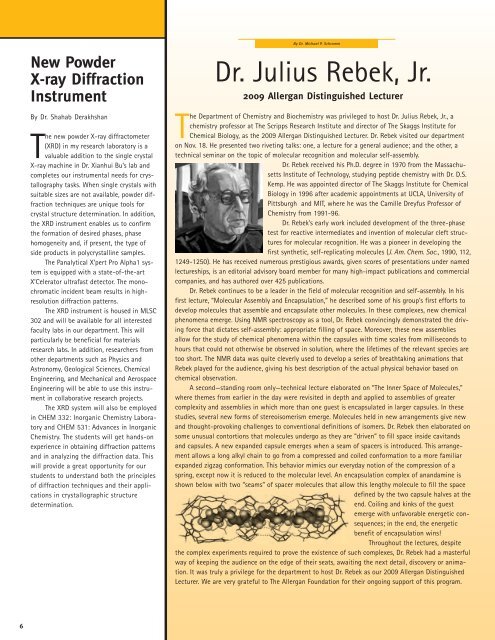
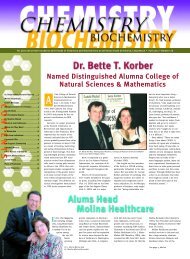
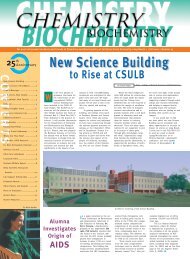
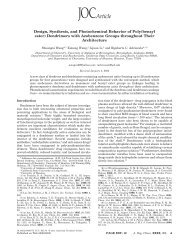
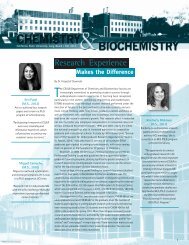
![Volume 4, Issue 3 [November 2012 pdf] - California State University ...](https://img.yumpu.com/34605825/1/190x245/volume-4-issue-3-november-2012-pdf-california-state-university-.jpg?quality=85)
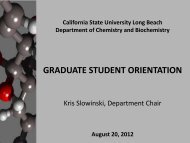
![Volume 5, Issue 2 [April 2013 pdf] - California State University, Long ...](https://img.yumpu.com/33273195/1/190x245/volume-5-issue-2-april-2013-pdf-california-state-university-long-.jpg?quality=85)
